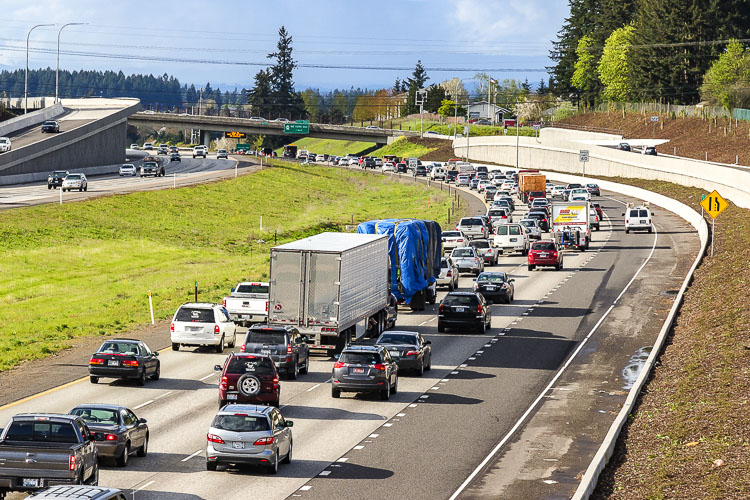Mariya Frost of the Washington Policy Center believes a recent presentation to the Washington State Transportation Commission shows the impact congestion relief could have on access to more jobs
Mariya Frost
Washington Policy Center
A recent presentation from INRIX to the Washington State Transportation Commission (WSTC) showed the impact that congestion relief could have on giving people better access to more jobs within just half an hour of Seattle.

Bob Pishue and Ted Trepanier, on behalf of INRIX, presented the latest data from the 14th annual INRIX Global Traffic Scorecard, which ranks and analyzes traffic congestion in 1,000 cities worldwide. INRIX looks at both commuting behaviors and trends, including the impact of COVID-19 on drivers and cities.

In 2020, according to the report, Seattle ranked as the 15th most congested city in the United States and the 130th most congested city in the world. People lost 25 hours to traffic congestion, or about $365 per driver. This is a 67 percent reduction from 2019. The data also showed a reduction in vehicle miles travelled in 2020 – as well as a fairly quick recovery in 2021 to pre-pandemic levels.
Reason Foundation’s Baruch Feigenbaum, in a study on increasing mobility in Southern California, noted that traffic congestion is important as it affects labor market size. He states, “most people will not spend more than a particular amount of time each day on a journey to work. As congestion increases, the number of miles they can travel within this amount of time decreases.” He goes on to say that in a large metro area, “economic productivity depends on matching skilled employees with employers who can make the best use of their abilities.” That productivity is achieved when the labor market size increases. Remy Prud-homme and Chang-Woon Lee studied the relationship between travel times and labor productivity in French cities and found that “when the effective labor market size increased by 10 percent, productivity (and hence the economic output) increased by 1.8 percent.”
The value of congestion relief for a labor market was illustrated well by an INRIX drive time visualization for Seattle that showed how far people could travel from the city center outwards in half an hour at 8:30 a.m. – in 2019 (blue) compared to 2020 (orange).
The data demonstrates what access to employment could look like with significant reductions in traffic congestion, particularly during the evening peak hours which have largely returned to pre-pandemic levels. This would have the double benefit of giving people more job options, and giving employers a larger pool of employees to choose from within the labor market.
Pishue calculated the difference between workers who can access downtown Seattle in 30 minutes in 2019 versus a less-congested 2020. According to his findings, at 8:30AM, more than 507,000 workers were within a 30-minute commute to downtown in 2019, versus 802,000 in 2020. This represents a 58 percent increase.
“Reducing traffic congestion is one of the best ways to improve access to vital goods and services, expand a business’ customer base, and attract employees with a smoother commute,” said Pishue. “With competition for employees rising, reducing traffic congestion significantly expands the potential labor pool of employers.”
Wendell Cox, a national transportation expert and urban policy analyst, often writes about the importance of giving people access to the greatest number of jobs within half an hour to reduce poverty and increase opportunities for affluence. In his study for WPC, he recommends orienting policy around minimizing travel times to employment, especially since the overwhelming share of population and increase in employment in the Puget Sound is outside the city of Seattle. Though Seattle has experienced significant growth since 2010, more than 85 percent of employment is outside downtown.
Transit, Cox noted, serves a niche market – with 48 percent of commutes to downtown Seattle taken on transit, and a 9.3 percent share to the rest of the city. Only 3.5 percent of work trip destinations in the rest of Puget Sound are reached by transit. In other words, most people outside of the downtown core drive to get to work.
Cox’s focus is reducing poverty by giving people competitive, expeditious access to employment. In most cases, data shows that the automobile is the best way to do that. The University of Minnesota’s “Access Across America” series showed that in 2019, people in US metro areas could access 47 percent of jobs by car in 30 minutes, compared to 8 percent of jobs by transit. Even in New York City’s metro area, drivers can access 13 percent of jobs in 30 minutes by car, compared to only 14 percent of jobs in 60 minutes by transit.
As policymakers deliberate transportation planning, equity issues, and public funding for transportation projects during the COVID recovery – they should consider access to employment as a key performance and equity measure. Improving access to employment will require accommodating, rather than limiting, automobile trips. It will require policies that make it easier for low-income people to own a car, rather than remain transit dependent. It will also require increasing roadway capacity and reducing traffic congestion to support reliable and safe commutes; encouraging telework where it makes sense to do so; and promoting technological innovation and modernization at transit agencies so that public transportation is more efficient and responsive to riders.
Needless to say, transportation solutions are generally a mix of efforts. However, as research from Cox and INRIX indicates, expanding the number of jobs people can reach in half an hour by car is an important place to start, and should take priority, if officials care about lifting people out of poverty and improving quality of life.
Mariya Frost is the director of the Coles Center for Transportation at the Washington Policy Center.




